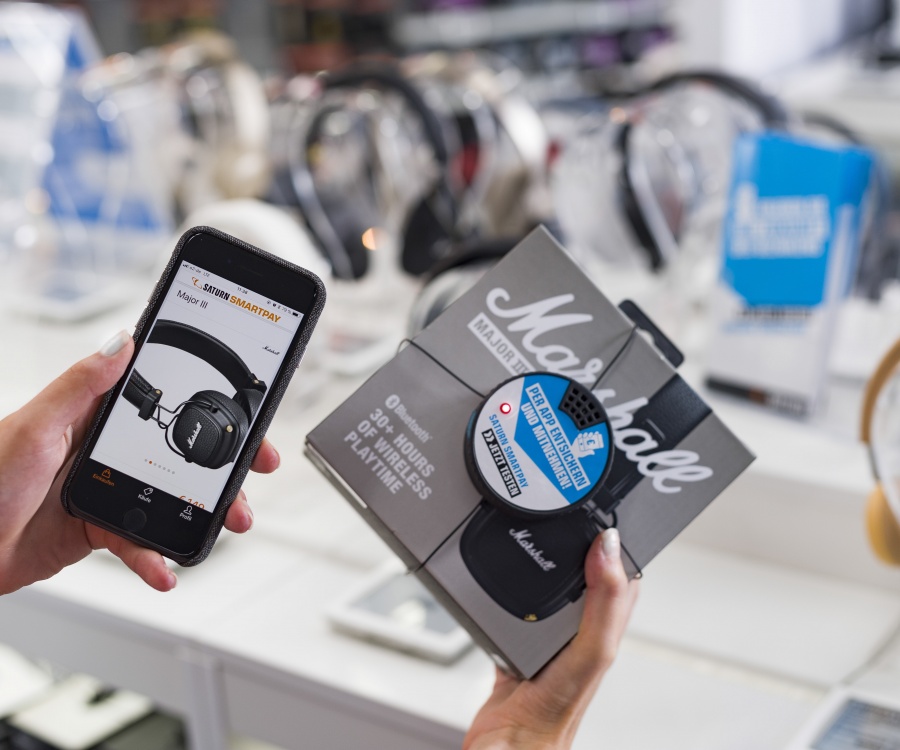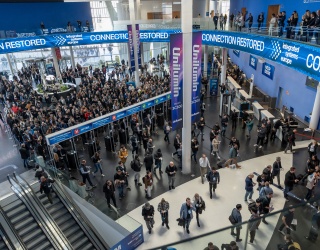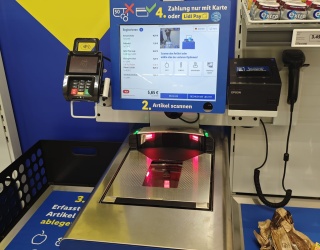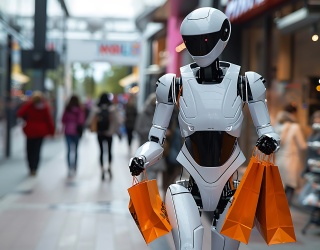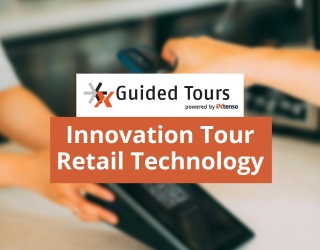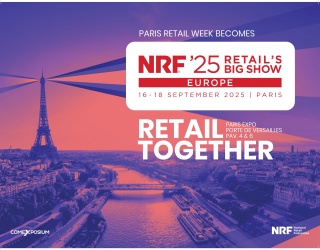
Scientists at the Fraunhofer FIT have developed a system that warns consumers through a ring on their finger that vibrates when they reach for unsuitable products. The technical requirement for this is RFID identification of the products, which the ring is able to read out. Erion Elmasllari from the Fraunhofer FIT talks about the difficulties and the requirements that make a sensible use of this system possible in retail.
For which target group is the so-called „magic ring“ intended?
When we started, we had allergic people in mind. As the project went on, we understood that everyone can be a user. For example, many people follow diets. Many others prefer bio food. Some people eat processed food, but want to stay away from too fatty or too sugary snacks. Almost all major religions forbid or discourage some foods. Finally, people boycott certain companies because of past bad experiences, or because those companies trade unfairly. We realized that the "Magic Ring" can be used by everyone. So we took everyone into account as a potential user.
The ring should allow a differentiated shopping. How does it work in detail and which technology is involved?
The particular technology is not as important as the interaction. Most things that the ring does can already be done with smartphones. The ring simply does them better and saves you time. For example, when you go shopping, you don't want to take a picture of all foods you pick, scan the barcodes, and then read on the smartphone's screen.
You'd be spending forever in the supermarket! How often would your phone accidentally fall on the floor because your hands are full? With the ring you just grab the food and put it in your bag. No reading, no scanning, no barcodes. Just grab the package. If it is the wrong food for you, the ring will vibrate before you've even had the time to put that package in your bag. The price displays will also tell you where to find a good alternative, so you don't spend time searching around.
The technology behind the Magic Ring is a mix of RFID, wireless communications (WiFi/Bluetooth), and web-services. Foods are marked by small RFID tags. These are tiny labels that can be read via radio waves from a very short distance. As soon as your hand grabs a food item, a sensor on the ring reads the RFID tag (i.e. the tiny label) and connects wirelessly to an ingredients database to ask for the ingredients of that food. If any of those ingredients are "unwanted" in your preferences, then the ring vibrates. It then asks the supermarket database for a similar product without unwanted ingredients, and finally uses the price displays on the shelf to show you the way to that product.
Which requirements need to be created in retail for a functioning system?
The main thing that the system needs is for food packages to have RFID tags. This is not a requirement that we are forcing on supermarkets. They want RFID tags since very long ago, because it saves them time at checkout. The only problem is that RFID tags still cost a bit more than what supermarkets are willing to pay for them, but this will not last long. Korean researchers have just developed some extremely cheap RFID tags, so we can expect all foods to be tagged by RFID in the very near future. As soon as that happens, the ring can be used effortlessly.
Data can only be selected if they have been deposited in a database. How does information get there and how can the user be sure that the imported data are correct?
There are many databases in the Internet where food information is kept. A lot of information is kept by government organizations that deal with food safety. Much can also be found in databases that volunteers maintain. With a little good will and a bit of social networking effort it will be easy to combine all of these sources into a big database for all kinds of foods. A kind of Food-pedia, if we can call it like that.
The other kind of databases needed are those that show what foods are available and where each food is inside the supermarket. But these are already kept by supermarkets for their internal management. It is in the supermarkets' best interest to make some of that data accessible, because when clients can save time, they are more satisfied, and their loyalty increases.
How do you ensure the safety of the data which contains the user’s intolerances or preferences deposited?
There are several ways of dealing with this.
First of all, the ring never sends out private data, like preferences. It does all the checks in its own processor; external systems don't even see what ingredient the ring is checking for.
A second defense is that there is no association between a user's identity and her preferences. The ring just serves whoever has it on the finger; it does not need to know the identity of that person.
A third line of defense is that many queries can be done via what's called "privacy preserving reconciliation". This means that the ring and the supermarket database will be able to agree on alternative foods without exchanging any information on the user's preferences.
Finally, the user's preferences can also be kept in a server that the user trusts, somewhere in the Internet. Nothing needs to be kept on the ring at all, so even if it is lost or stolen, nobody can find information in it.
How takes the matching of data place and which problems can occur? Is it possible to apply the ring on all products and which articles are problematic because of their texture?
In supermarkets, where the package is tagged by RFID, the ring will be able to say whether a food matches the user's preferences or not. If the food is not in the database, the ring will signal the user to be careful and at least check the printed label.
Fresh, unpackaged foods sold at farmer's markets are usually not tagged by RFID. The Magic Ring technology cannot identify such foods. But at Fraunhofer FIT we focus on what the user is trying to do, not on the technology itself. So we have thought a very easy solution, which is ubiquitous, non-intrusive, and positive for both seller and buyer. We noticed that buyers in fresh markets typically like to inspect fresh foods and touch them, for example they touch an avocado to see how ripe it is. Sellers, on the other hand, for hygiene reasons, don't like to have their products touched and handled by everyone. The solution we propose is for the seller to tag just one sample with RFID and leave it for people to touch and inspect. When people with the ring take that sample avocado in their hand, the Magic Ring will detect it and advise accordingly. Result: happy users. When people without the ring touch and inspect the avocado, they can feel the ripeness and other characteristics before they buy. Result: confident, happy buyers. Finally, sellers are happy because the rest of their produce will remain untouched and clean.
Is the “Magic Ring“ a ring for life? What is the service life of this product?
There is still a lot of place for improvement here, not less because we wanted to get the interaction right before first, so we didn't focus a lot on the electronics. Our ultimate vision is for the Magic Ring to be charged in an unobtrusive way. This means people should just put it on their finger and never need to take it off. We are currently thinking of ways to charge the ring directly on the finger. The more exotic involve generating electricity from daily activities, like walking, shaking hands, and so on. The simpler ones involve wireless chargers. For example, we could get the charger of an electric toothbrush (the base), put it inside a normal computer mouse, and thus charge the Magic Ring while the user is working or playing with the computer. The user would not even understand that the ring is charging. However, we are still in the phase of generating ideas; we have not yet decided on the best one and we are very open to new suggestions.
Which added value does it have for the retailer? Which special incentives must be there to introduce the system?
I hinted at the benefits in the answers above. Supermarkets want RFID tagging for their own purposes, not because of the ring. We are just piggybacking on this RFID infrastructure to offer something new. By supporting the Magic Ring, supermarkets get more customer satisfaction, which translates to customer loyalty. Small sellers at fresh markets do not need to make any big investments to attract more customers. The cost for a small seller would be only a few euros for 20-30 rewritable RFID tags.
RFID in retail is currently rather more used in logistic areas? When can we count with the introduction of the ring to the retail?
RFID has some advantages compared to barcodes. For example, if products are tagged by RFID, they can be identified and billed without taking them out of the shopping cart, saving time and labour for the supermarket. The reason why supermarkets use barcodes is that RFID tags cost around 5-8 cents per tag, which is more than supermarkets can afford to pay. RFID is used widely in logistics because the advantages there are already worth the cost. As soon as the price drops under one cent per tag, supermarkets will use RFID too; it's simply in their interest to do so. We are preparing the ring for this day and looking for industry partners to help us develop the ring further, make it look beautiful, and produce it at an affordable cost.
Ingrid Spicker, First publication: InterMopro.de



